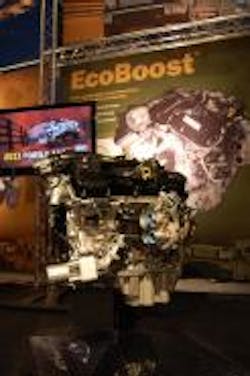“Truck customers should think of the EcoBoost truck engine as a gas-powered engine with diesel-type capability and characteristics.” –Jim Mazuchowski, V6 engines program manager, Ford Motor Co.
It’s hard to miss the potential impact of the next generation of gasoline-powered V6 engines like Ford’s new EcoBoost on the light-duty truck market – especially for commercial users.
Now, I can’t talk about my personal perceptions of Ford Motor Co.’s new twin-turbocharged 3.5-liter V6 twin independent variable camshaft timing (Ti-VCT) EcoBoost quite yet (us truck writers are under and embargo until Sept. 27)
But I can tell you this engine is most certainly the leading indicator of a technological sea change in the light-duty truck world, for the fuel economy numbers I racked up alone in 127.2 miles of road testing are going to find broad appeal to any number of commercial fleets.
Now, I touched on the potential capabilities of the EcoBoost yesterday, but that post only scratches the surface this new engine. For starters, this 3.5-liter cranks out 365 hp and 420 ft-lbs of torque while delivering 20% better fuel economy than the previous 4.2-liter V6 it replaces – all on regular 87 octane fuel.
[Below, Jim Mazuchowski, Ford’s V6 engines program manager, gives an overview of the key technologies within the EcoBoost engine.]
By contrast, Ford’s new big 6.2-liter V8 generates 411 hp and 434 ft-lbs of torque only on “premium” 93-octane fuel, yet it’s towing rating is the same as the smaller EcoBoost – 11,300 lbs.
Think about this, too: as a “naturally aspirated” engine, the big 6.2-liter V8 is susceptible to a power falloff at high altitudes – anywhere from 25% to 30% at 10,000 ft elevations. That doesn’t happen to the EcoBoost, though, because of its turbocharging.
Jim Mazuchowski (at left), Ford’s V6 engines program manager, told me during the company's recent 2011 model F-150 event held at the Texas Motor Speedway outside Ft. Worth that it’s the combination of turbocharging and direct fuel injection that's key.
For it's that combination that delivers a lot of low-end torque and maintains it across a broad rpm range – with up to 90% of the peak torque available from 1,700 rpm to 5,000 rpm – all on regular fuel.
[For fun, here’s a 40 to 70 mile per hour engine test run on a mobile dynamometer Ford brought to its 2011 model F-150 rollout.]
“This is good news for customers because the combination of reaching peak torque at a lower engine speed, and maintaining that torque for a longer period, brings new levels of fuel efficiency with maximum towing capability,” he said. “The twin turbochargers and direct injection also give it the broad, flat torque curve that makes towing with a diesel so effortless.
And there, perhaps, is the biggest key point in this discussion.
Here’s small V6 that offers almost – and I stress the word “almost” here – diesel-like horsepower and torque, without the pricey emission control technology. Now, true, Ford is marketing its EcoBoost truck engine as a “premium” option, so it’s looking to make some money here on it.
But if a commercial fleet can get by on the payload and towing ratings the engine provides, it could very well make that up-front money back in fuel savings – something that’s a lot harder to do with today’s more costly diesels.
The Ti-VCT technology on the EcoBoost also helps in the emission-control arena as well as to save fuel, Mazuchowski noted. By providing extremely precise variable – yet independent – control of timing for intake and exhaust valves, the Ti-VCT package reduces emissions, especially in situations when the throttle is partially open.
Independent adjustment of intake and exhaust valve timing also allows maximum fuel economy at part-throttle, while delivering optimized power in full-throttle situations. An added benefit is improved driveability and responsiveness across the torque curve, Mazuchowski noted.
Now, the EcoBoost won’t be available until next year on Ford’s new F-150, but it’s already reshaping the automaker’s product offerings.
For starters, Ford plans to discontinue selling its line of Ranger compact pickups in the U.S. precisely because it now has a fuel sipping V6 that puts its full size F-150 on almost on even fuel economy footing with the Ranger. The USA Today newspaper reports that while the 2011 model Ranger is being redesigned and upgraded for other markets, such as Australia, it’ll be shelved in the U.S. due in no small part to what the EcoBoost can bring to the F-150.
Besides, getting a full-size pickup with diesel-like payload and towing capability, with the potential fuel economy footprint of the compact Ranger, seems like a no-brainer here.
The hardest part of course is convincing the commercial and consumer truck buyer alike that the EcoBoost really does what Ford says it does – Mazuchowski admitted as much to me.
While Ford’s done an awful lot of validation work on the EcoBoost, the salient of “customer acceptance” remains to be breeched.
Here, by the way, it’s what Ford’s done to test the truck version of its EcoBoost:
• More than 1.5 million hours of analytical time;
• More than 13,000 hours of dynamometer testing, including more than 5,000 hours at full boost and more than 2,500 hours at or above 5,000 rpm (dyno testing helps ensure durability in excess of 150,000 miles, the company said);
• More than 100,000 hours of vehicle test time encompassing the full range of potential customer operating conditions;
• Thermal cycling tests that replicate conditions from the Arctic Circle to Death Valley, simulating 10 years of use in the harshest environments.
Altogether, these tests replicate more than 1.6 million miles of harshest type of customer usage. But will that data – alongside the horsepower, torque, payload, towing, and fuel economy numbers – be enough? That all depends on what customers experience when they start driving trucks equipped with the EcoBoost – and that won’t happen until next year.
